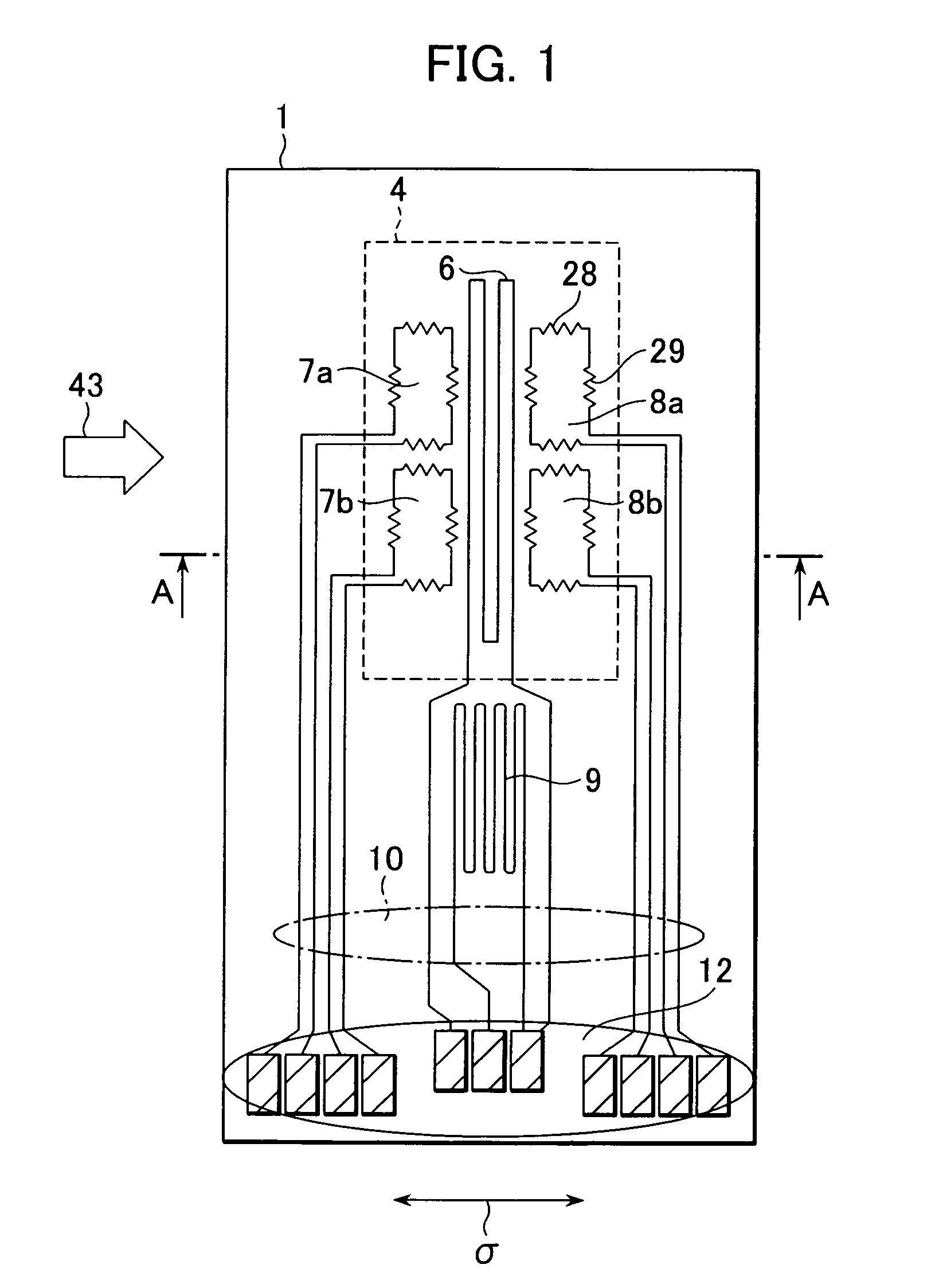Physical quantity sensor
a sensor and physical quantity technology, applied in the field of sensors, can solve the problems of affecting the whole of the sensor device, the diaphragm section of the sensor, so as to reduce the influence of the mounting member on the sensor device, reduce the effect of the stress imposed, and improve the accuracy of measuremen
- Summary
- Abstract
- Description
- Claims
- Application Information
AI Technical Summary
Benefits of technology
Problems solved by technology
Method used
Image
Examples
first embodiment
[0034]The first embodiment represents, as one example of the physical quantity sensor, a thermal air flow sensor for measuring the flow rate of intake air in an internal combustion engine of an automobile, etc.
[0035]FIG. 1 is a schematic plan view of a sensor device of the thermal air flow sensor according to the first embodiment, and FIG. 2 is a sectional view taken along the line A-A in FIG. 1. As shown in these drawings, a sensor device 1 is formed on a semiconductor substrate (base) 2 made of a single-crystalline silicon (Si) wafer as follows.
[0036]A cavity 3 is formed in a part of the semiconductor substrate 2 by anisotropic etching. The cavity 3 is in the form of a rectangular hole as viewed in a plan. A diaphragm 4 is formed at one side of the cavity 3. The diaphragm 4 is made of an electric insulating film 5 of silicon dioxide (SiO2) that is formed on one surface of the semiconductor substrate 2 by thermal oxidation or CVD (Chemical Vapor Deposition).
[0037]A heating resistor...
second embodiment
[0058]A second embodiment will be described below with reference to FIG. 7. This embodiment also represents the case where the present invention is applied to the thermal air flow meter. Since the basic principle and structure are the same as those in the first embodiment, only different points are described here and a description of common points is omitted.
[0059]FIG. 7 is a plan view showing shapes of the temperature sensitive resistors 8a and 8b in this second embodiment. While in the first embodiment the temperature sensitive resistors 8a and 8b are arranged in separate areas divided in the vertical direction along the length of the heating resistor 6, the temperature sensitive resistors 8a and 8b in the second embodiment are arranged in such a way that the respective vertical resistance components and the respective horizontal resistance components of the temperature sensitive resistors 8a and 8b are extended in interdigitated (or interlaced) relation in parallel as shown. Furt...
third embodiment
[0065]A third embodiment will be described below. This embodiment represents the case where the present invention is applied to an acceleration sensor of the type employing a heating resistor, which can be used as an acceleration sensor and an inclination sensor in an automobile, etc.
[0066]One example of the known heating-resistor acceleration sensor is disclosed in U.S. Pat. No. 5,581,034.
[0067]FIG. 8 is a schematic plan view of a sensor device of a thermal acceleration sensor according to the second embodiment, and FIG. 9 is a sectional view taken along the line B-B in FIG. 8. Though not shown in these drawings, a sensor device 30 is mounted in an enclosed container which is filled with a fluid having a small thermal conductivity, such as air or xenon (Xe).
[0068]As shown in FIGS. 8 and 9, the sensor device 30 is entirely formed by using, as a base, a semiconductor substrate 31 made of a single-crystalline silicon (Si) wafer. A cavity 34 is formed in a part of the semiconductor sub...
PUM
 Login to View More
Login to View More Abstract
Description
Claims
Application Information
 Login to View More
Login to View More - R&D
- Intellectual Property
- Life Sciences
- Materials
- Tech Scout
- Unparalleled Data Quality
- Higher Quality Content
- 60% Fewer Hallucinations
Browse by: Latest US Patents, China's latest patents, Technical Efficacy Thesaurus, Application Domain, Technology Topic, Popular Technical Reports.
© 2025 PatSnap. All rights reserved.Legal|Privacy policy|Modern Slavery Act Transparency Statement|Sitemap|About US| Contact US: help@patsnap.com



